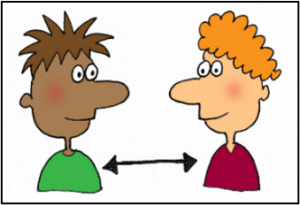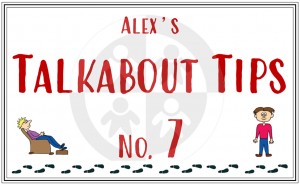Our feet and legs… what are they saying?
What’s in this issue of Alex’s Talkabout Tips?
Welcome to my seventh Talkabout Tips, and in this issue, I am continuing with the topic of body language, and I am going to focus on feet and legs. When we think about communication, we don’t immediately think about our lower limbs, but our feet and legs can give quite a lot away. We are much more aware of our hands and arms when we are talking and so we learn to control them if we need to, but we rarely think of controlling what our legs are communicating! In fact, our lower limbs are often thought to be the most honest part of our body language because they are furthest away from our brain and therefore there is less conscious thought involved!
So, what are the important things we need to know about our feet and legs, and our proximity?
Feet
 Our feet can give away a lot of information. We are all conditioned to turn towards things we like, and our feet will do the same. So next time you are talking to someone, check out the direction their feet. Both feet pointing towards you is a good sign. One pointing away (often towards the exit), may mean they want to get going. Both pointing away – well – you should probably wrap things up!
Our feet can give away a lot of information. We are all conditioned to turn towards things we like, and our feet will do the same. So next time you are talking to someone, check out the direction their feet. Both feet pointing towards you is a good sign. One pointing away (often towards the exit), may mean they want to get going. Both pointing away – well – you should probably wrap things up!
You can also look at movements – the feet displace energy (see Talkabout Tips 5) by tapping, bouncing, kicking, and this usually means there are keen to leave or are running out of patience. We also see an increase in lower body movements when someone is lying, which may explain why some people like to talk to us from behind a desk.
Legs
 Ours legs, like our feet, give clues as to where someone would like to be and what their intentions are. We move towards what we want, and we move away from what we don’t want. And generally, open or uncrossed leg positions show an open or dominant attitude and crossed positions reveal closed or uncertainty.
Ours legs, like our feet, give clues as to where someone would like to be and what their intentions are. We move towards what we want, and we move away from what we don’t want. And generally, open or uncrossed leg positions show an open or dominant attitude and crossed positions reveal closed or uncertainty.
We all stand and sit in different positions, and they can mean different things…
Standing positions
 There are 4 main standing positions…
There are 4 main standing positions…
1. At attention, legs together and upright. This says ‘no comment’ and is often seen in a formal setting or when talking to the boss.
2. Leg cross shows a closed submissive or defensive attitude. It can also make people look insecure.
3. Foot forward – this is where the body weight shifts to one hip and one foot points to where they want to go.
4. Legs apart is a dominant posture, sometimes referred to as ‘the crotch displayer’ as it highlights the genitals. This is often seen in men, but is not the case, if the person’s hands are covering their crotch – this is then called ‘the broken zipper’ posture (see Talkabout Tips 6).
Sitting positions
There are 3 main seated positions…

1. The leg cross is a very common posture, particularly in women, and it can reveal a negative attitude especially if arms are crossed too. But always look at the 3 Cs (context, congruence and clusters – explained in Talkabout Tips no 5). So, if you have to sit with your legs crossed and you don’t want to appear negative, just make sure the rest of your posture is open.

2. The figure four is seen more in men than in women and is where one leg is crossed over with its ankle supported by the knee of the other leg. It is a seated version of the crotch display and shows an argumentative or competitive attitude. If the person also puts their hands behind their head, this shows a superior attitude, – ‘one day you could be as wonderful as me’. And if the legs are open, then this shows arrogance or dominance.
 3. The ankle lock can look different in men and women. Men are more likely to have their legs open and women will keep their knees together. In both cases the feet tend to be withdrawn under the chair. It is your legs version of ‘biting your lips’ – it shows a withdrawn attitude and holding back an emotion. Here’s an interesting fact about ankle locking… Did you know that 68% of people lock their ankles as soon as they sit in the dentist chair and 98% lock their ankles when the dentist administers an injection?!
3. The ankle lock can look different in men and women. Men are more likely to have their legs open and women will keep their knees together. In both cases the feet tend to be withdrawn under the chair. It is your legs version of ‘biting your lips’ – it shows a withdrawn attitude and holding back an emotion. Here’s an interesting fact about ankle locking… Did you know that 68% of people lock their ankles as soon as they sit in the dentist chair and 98% lock their ankles when the dentist administers an injection?!
Proximity
 Of course, where and how we stand and sit, will also affect our proximity and how we use space to create a ‘bubble’ around us for protection.
Of course, where and how we stand and sit, will also affect our proximity and how we use space to create a ‘bubble’ around us for protection.
In general, we can identify 4 zones of personal space:
1. The intimate zone (15-45cms) – only people who are emotionally close to us are allowed in this space. There is also a ‘close intimate zone’ of less than 15cms and this is reserved for the very few people who we don’t mind touching us.
2. The personal zone (46cms – 1.22m) – this is the most important one for people to learn as it is our ‘one arm length’ rule which is the ideal one in the western world for personal interaction.
3. The social zone (1.22-3.6m) – we stand at this distance from people we don’t know.
4. The public zone (over 3.6m) – this is when we have to address a large group of people, and this is considered to be an acceptable distance from the first row.
There are several factors that will affect the distance rule though. Like animals, the size of our bubble is dependent on the density of the population in the place we grew up, so sometimes we need to make adjustments. So, for example, southern Europeans tend to stand closer than northern Europeans, and so they may come across as pushy or too familiar to northern Europeans, but in contrast, northern Europeans may appear cold or stand offish.
Height and gender will also impact on proximity. Where there is a large height difference, we will need to increase the space to allow for a less acute angle for eye contact, and all the distances tend to reduce between 2 women and increase between 2 men.
Of course, sometimes we have to get closer to people in situations like a lift or a crowded train. We cope with people entering our ‘intimate zone’ by masking our emotions and pretending that the other people are inanimate.
And we all appear to abide by the international ‘rule of the lift’…
2. There will be no eye contact
3. We will maintain a poker face
4. We will pretend to be deeply engrossed in our book / paper
5. We will not move our bodies
6. We will watch the floor numbers change
In summary…
So, in this third issue about body language, I have talked about why it is important to understand what our feet and legs are communicating, from how we sit and stand, to how close we get to people, and I hope you have found it interesting. In the next issue, we will start to think about faces.
As always, this is just the essential bits! You can read more about all of this in my book ‘Social Skills: developing effective interpersonal communication’(Kelly, 2019).
Please do comment on Facebook or share this with others. If you would like to be added to my email distribution list, please contact me through the website, email me directly or PM me.
Thanks for reading!
alex@alexkelly.biz







